
Sparidae is a family of ray-finned fishes belonging to the order Spariformes, the sea breams and porgies, although they were traditionally classified in the order Perciformes. They are found in shallow temperate and tropical waters around the world and are demersal carnivores.

Coryphaena is a genus of marine ray-finned fishes known as the dolphinfishes, and is currently the only known genus in the family Coryphaenidae. The generic name is from Greek κορυφή and -αινα. Species in this genus have compressed heads and single dorsal fins that run the entire length of the fishes' bodies.

The Lamnidae are the family of mackerel sharks known as white sharks. They are large, fast-swimming predatory fish found in oceans worldwide, though prefer environments with colder water. The name of the family is formed from the Greek word lamna, which means "fish of prey", and was derived from the Greek legendary creature, the Lamia.

The Carangidae are a family of ray-finned fish that includes the jacks, pompanos, jack mackerels, runners, trevallies, and scads. It is the largest of the six families included within the order Carangiformes. Some authorities classify it as the only family within that order but molecular and anatomical studies indicate that there is a close relationship between this family and the five former Perciform families which make up the Carangiformes.

Ephippidae is a family of percomorph fishes, the spadefishes, in the order Moroniformes. These fishes are found in the tropical and temperate oceans of the world, except for the central Pacific.

The superorder Elopomorpha contains a variety of types of fishes that range from typical silvery-colored species, such as the tarpons and ladyfishes of the Elopiformes and the bonefishes of the Albuliformes, to the long and slender, smooth-bodied eels of the Anguilliformes. The one characteristic uniting this group of fishes is they all have leptocephalus larvae, which are unique to the Elopomorpha. No other fishes have this type of larvae.

The mojarras are a family, Gerreidae, of fish in the order Perciformes. The family includes about 53 species found worldwide in tropical and warm temperate regions. They mostly inhabit coastal salt and brackish waters, although some occur in fresh water.
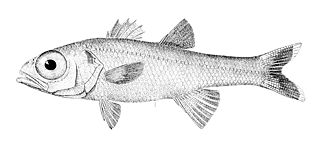
Epigonidae, the deepwater cardinalfishes, are a family of perciform fishes. The family includes about 43 species.
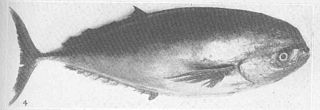
The louvar or luvar is a species of marine ray-finned fish, it is the only extant species in the genus Luvarus and family Luvaridae. This taxon is classified within the suborder Acanthuroidei, which includes the surgeonfish, of the order Acanthuriformes, and is the only pelagic species of this order. The juvenile form has a pair of spines near the base of the tail, like the surgeonfish, though they are lost in the adult.

Luvarus is a genus of ray-finned fishes belonging to the family Luvaridae. It is the only extant genus in that family and its only extant species is the cosmopolitan louvar.

Albulidae is a family of fish, commonly known as the bonefishes, that are popular as game fish in Florida, select locations in the South Pacific and the Bahamas and elsewhere. The family is small, with 11 species in 3 genera. Presently, the bonefishes are in their own order: Albuliformes. The families Halosauridae and Notacanthidae were previously classified in this order, but are now, according to FishBase, given their own order Notacanthiformes. The largest bonefish caught in the Western Hemisphere is a 16-pound, 3 ounce example caught off Islamorada, Florida, on March 19, 2007.
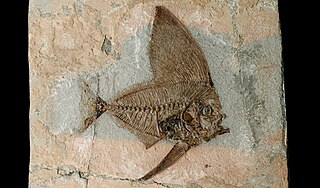
Exellia is a genus of extinct spadefish that lived in the Tethys Ocean during the early Paleogene. The adult form is shaped akin to a large spadefish or a short dolphinfish, with very large pelvic fins, and a long dorsal fin starting from in front of the eyes to near the base of the caudal peduncle. The juvenile form resembles a juvenile drumfish, with the dorsal fin forming a long crest on top of the head.

Eoluvarus bondei is a species of extinct bony fish once identified as being a luvar from the Fuller's Earth Ypresian formation of the Barmer District of Rajasthan, India. Later, better quality specimens were found, and E. bondei was reappraised as being a relative of the prehistoric spadefish, Exellia.

Luvarus necopinatus is a species of extinct louvar that lived in the Tethys Ocean during the early Paleogene. It differs from the modern species, L. imperialis, in that L. necopinatus has an oval body shape, and is around one foot in length when fully grown.
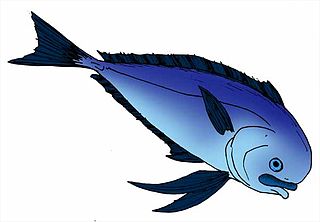
Aluvarus praeimperialis is an extinct bony fish, known from two headless fossil specimens found in the Elam Formation, a Lower Oligocene stratum from the Rupelian epoch, of what is now Iran. A. praeimperialis was originally thought to be a luvar, described as "Luvarus praeimperialis", as it was thought to be a predecessor to the modern luvar. A later reexamination of the specimens showed that they were too incomplete to demonstrate such a conclusion and had no clear exclusive shared traits with luvar, and were renamed "Aluvarus", meaning "not luvar" or "different than luvar". However, some authorities still retain it as a luvar.

Labriformes is an order of ray-finned fishes which includes the wrasses, cales and parrotfishes, within the clade Percomorpha. Some authors include the Labriformes as the clade Labroidei within the Perciformes while others include more families within the Labriformes, such as the cichlids and damselfishes, but the 5th edition of Fishes of the World includes just three listed in the section below and includes 87 genera and about 630 species.

Ophidiinae is a subfamily of the cusk eel family Ophidiidae. The species in the subfamily are characterised by having their pelvic fins situated far forward on the body and supported by a forward orientated extension of the pelvic girdle, they lack barbels on the mouth and chin and they are covered in small cycloid scales arranged in horizontal or diagonal rows. Some species have a modified swim bladder and the anterior vertebrae which enables them to generate sounds. and some of these modifications are sexually dimorphic and make the fish capable of generating sound. They have two rays in each ventral fin and the caudal fin has 9 rays. Most species are benthic and occur on the continental shelf.
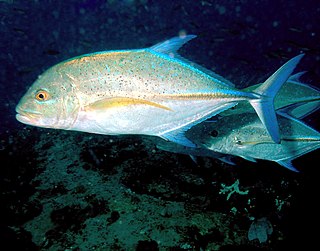
Carangiformes is an order of ray-finned fishes that is part of a sister clade to the Ovalentaria, the other orders in the clade being the Synbranchiformes, Anabantiformes, Istiophoriformes, and Pleuronectiformes. The Carangiformes have been long regarded as a monotypic order with only the family Carangidae within it by some authorities, and the other current families within the order have been previously classified as part of the wider order Perciformes. The 5th edition of Fishes of the World classify six families within Carangiformes, with other authorities expanding the order to include up to 30 families.
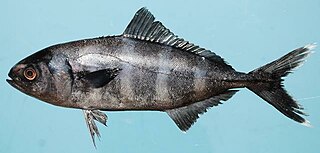
Naucratinae is a subfamily of ray-finned fish from the family Carangidae which consists of five genera and 13 species.

Acanthuriformes is an order of ray-finned fishes, part of the Percomorpha clade. Some authorities place the fishes in the order within the Acanthuriformes in the suborders Acanthuroidea and Percoidea of the order Perciformes.



















